Tuesday Triage #52
- TUESDAY TRIAGE #52 by Vadim Drobinin
- On memories and food
- Things I enjoyed reading
- 1. First-class flights, chauffeurs and bribery: the secret life of a private tutor by Emma Irving
- 2. How I accidentally took down GitHub Actions by @not_an_aardvark
- 3. The coupon code is a slap in the face by @mijustin
- 4. What happened when I stopped using Emojis by @This2ShallGrow
- 5. How to manually merge two Apple IDs to one by @brianstucki
- 6. The centuries-old sport of karate by Tony Perrottet
- 7. Building a Vision of Life Without Work by livafi
- 8. Dependencies by @chriseidhof
- 9. London Beats New York Back to Office, by a Latte by @_jsdiamond and @tgbuckley
- 10. “Cat Person” and Me by Alexis Nowicki
- Things I didn't know last Tuesday
- 1. Gibraltar Airport
- 2. Urumi
- 3. Royal Mail rubber band
- 4. Vladimir Lukyanov’s Water Computer
- 5. Thomas Linley the younger
- 6. White Horses of Wiltshire
- 7. Taste Garlic with your feet
- 8. Christmas controversies
- 9. Through the grapevine
- 10. Eigengrau
- Book of the week
- Thank you and see you in a week!
TUESDAY TRIAGE #52
by Vadim Drobinin ¶
Your weekly crème de la crème of the Internet is here!
13.07.2021 (read in browser)
On memories and food ¶
This week we went for a set of dishes inspired by China, and while the food was (mostly) impeccable, it got me thinking a lot about the way our prior experience shapes how we process food.
The restaurant we have visited is running menus with six dishes, which they change every six weeks. I've briefly wrote about my experience after their previous set, called The Circus.
The Circus was very easy to comprehend: names like "The Illusionist" or "The Grand Finale" brought memories of going to a circus in my childhood, and the emotions were very familiar too.
This time the menu was called Shanghai, and while I am relatively used to the staples of Chinease cuisine, most of the things we were served didn't have enough emotional value for me and as the result just stayed... well... rather plain.
The set opens up with a prawn toast: a brilliant use of miso butter (just red miso wipped with unsalted butter) but everything else looks slightly odd.
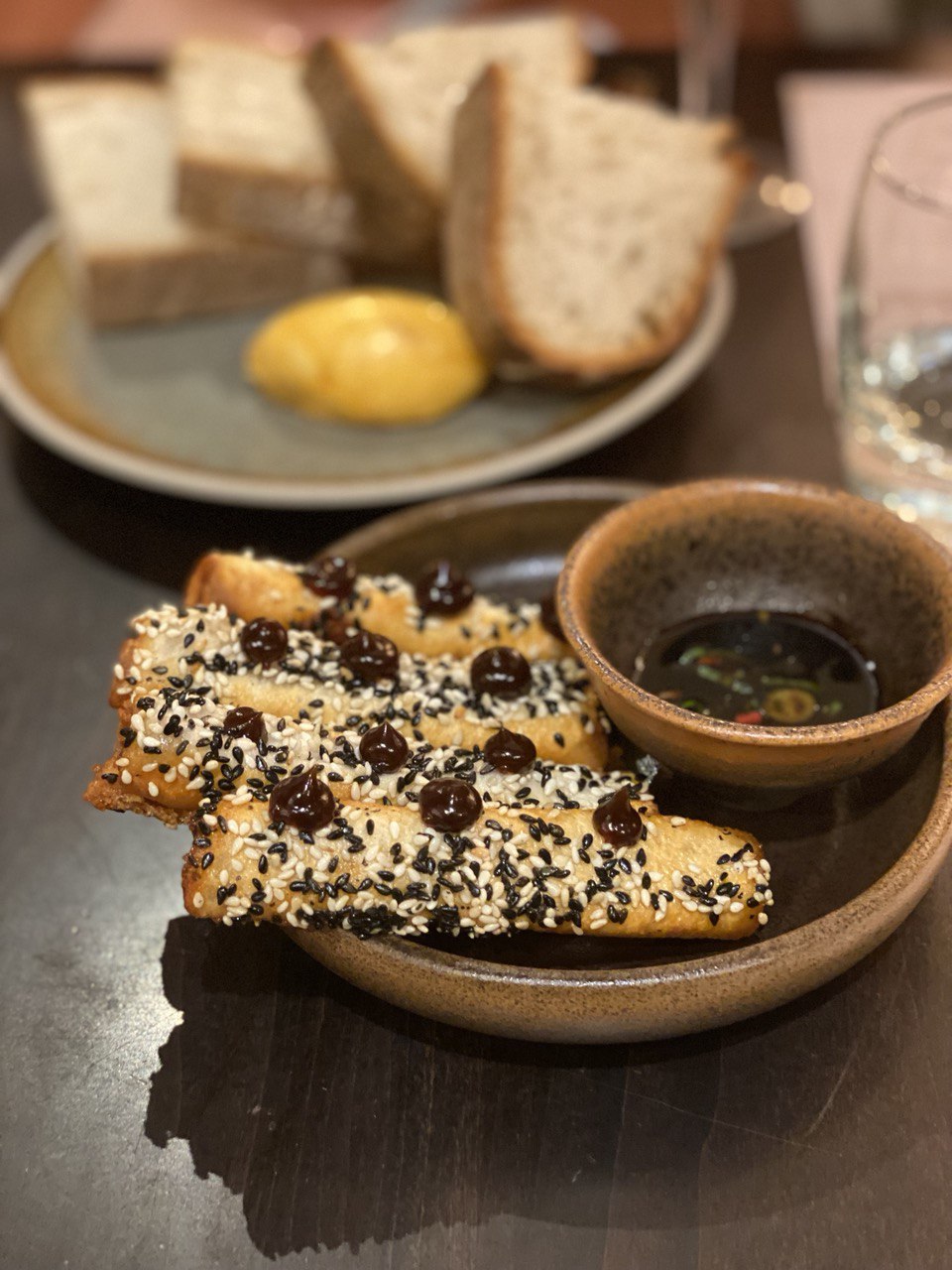
The first course is a char siu pork mantou steamed bun, and while I had my share of steamed buns before, they never got soaked in pork broth. It was nice but inconvenient.

Then we were served some dengzhou chicken, and spent quite some time trying to understand the origins of the name. Brief googling prompts some huge poultry market in Dengzhou, but I'd think it's quite common for cities in general.
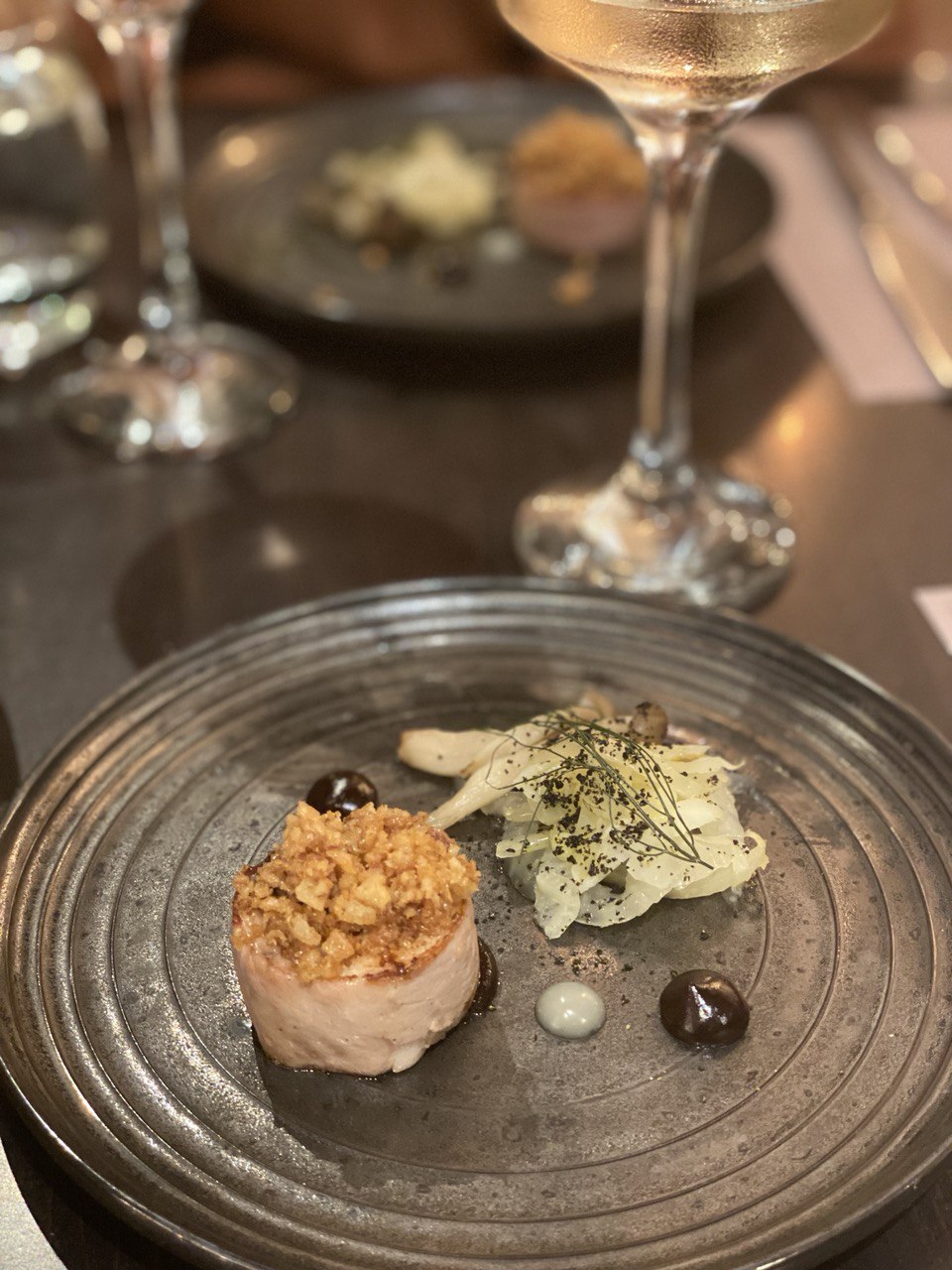
The next course, called Mushroom medicine, was one of my favourite, thanks to a bunch of unexpected textures.
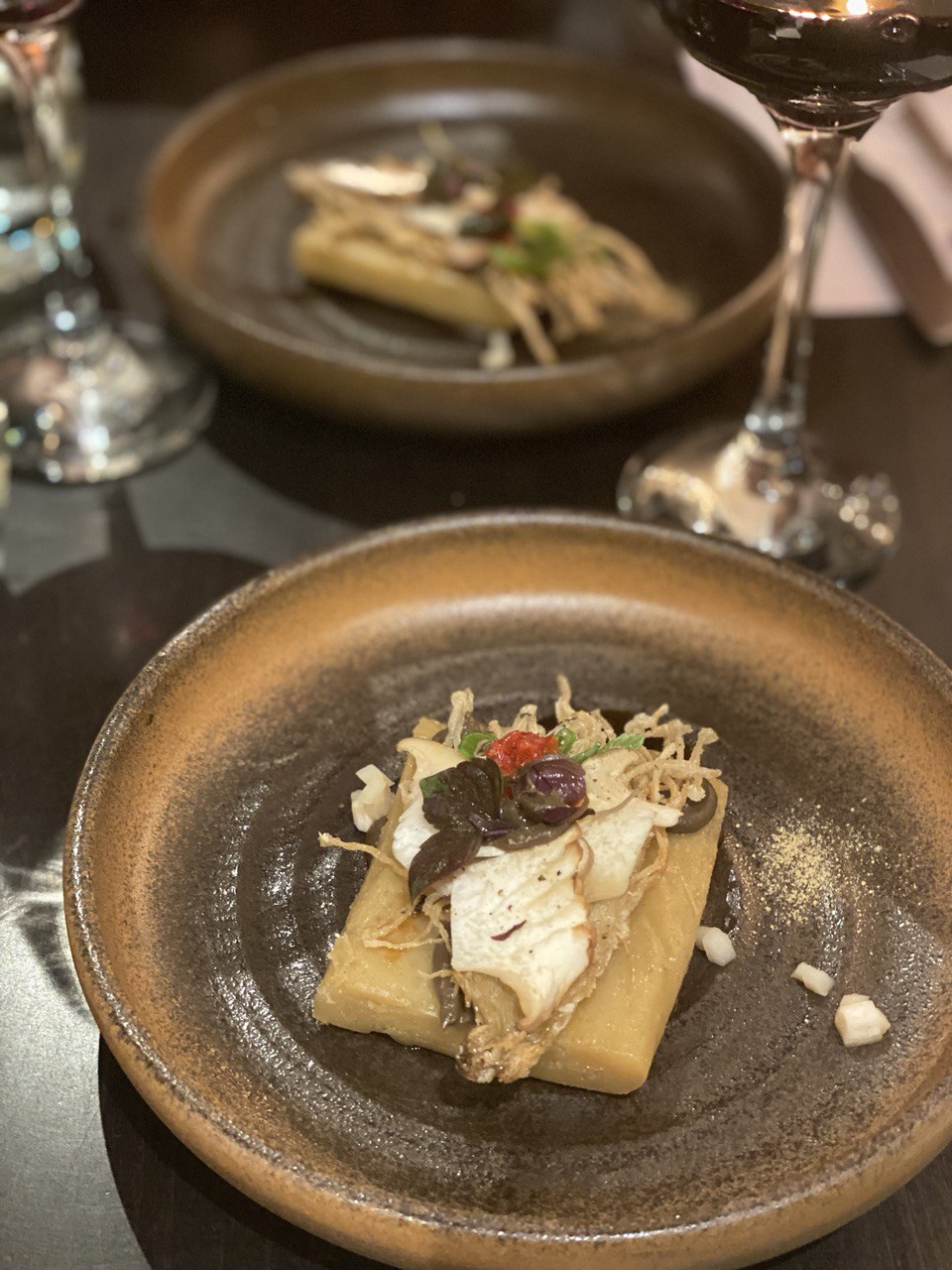
Another great course, featuring cod and peanut sauce:
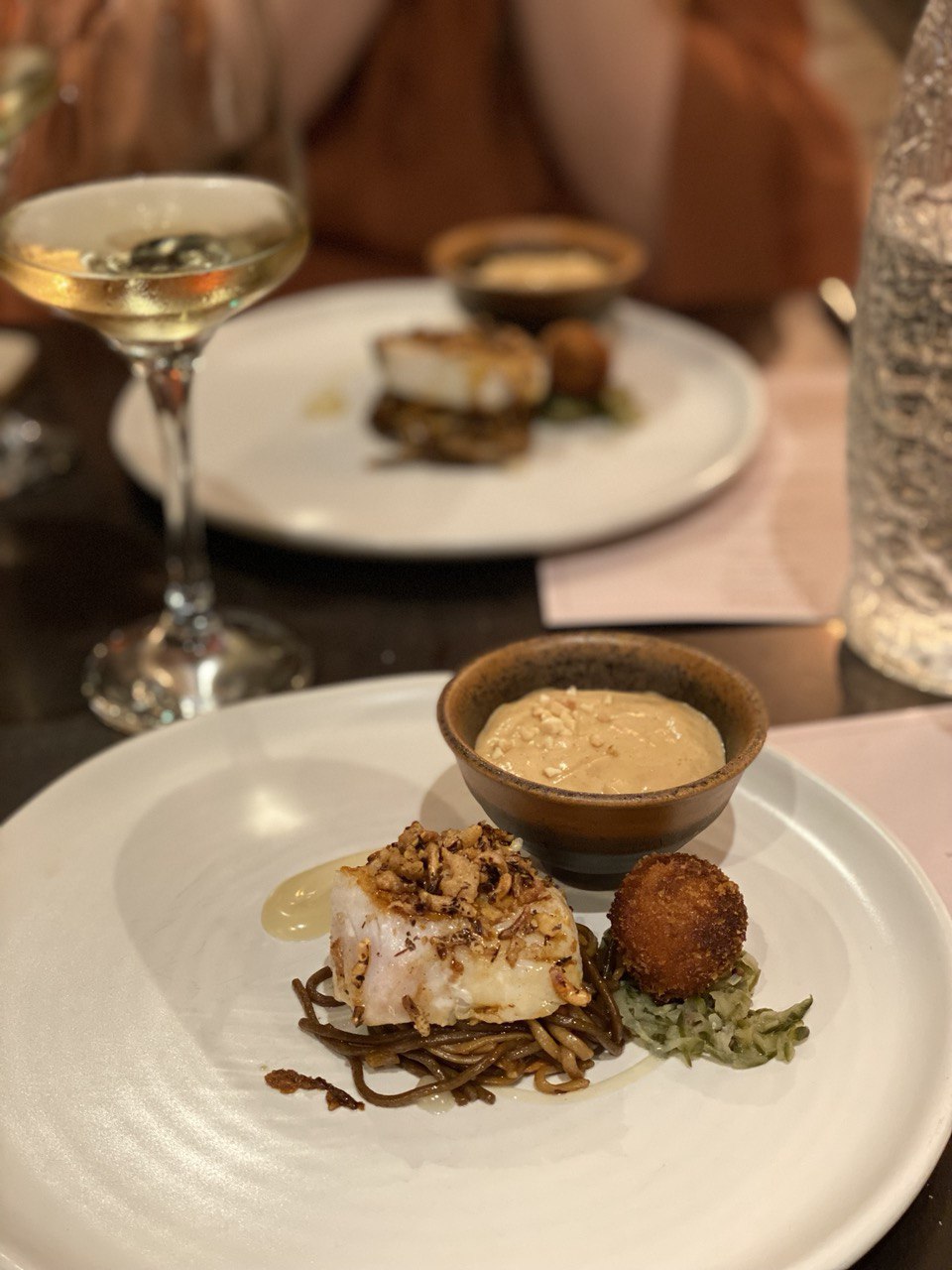
And then an impossible to chew piece of beef with undercooked broccoli. I had a traumatizing experience with broccoli just one week ago and yet here we go again.
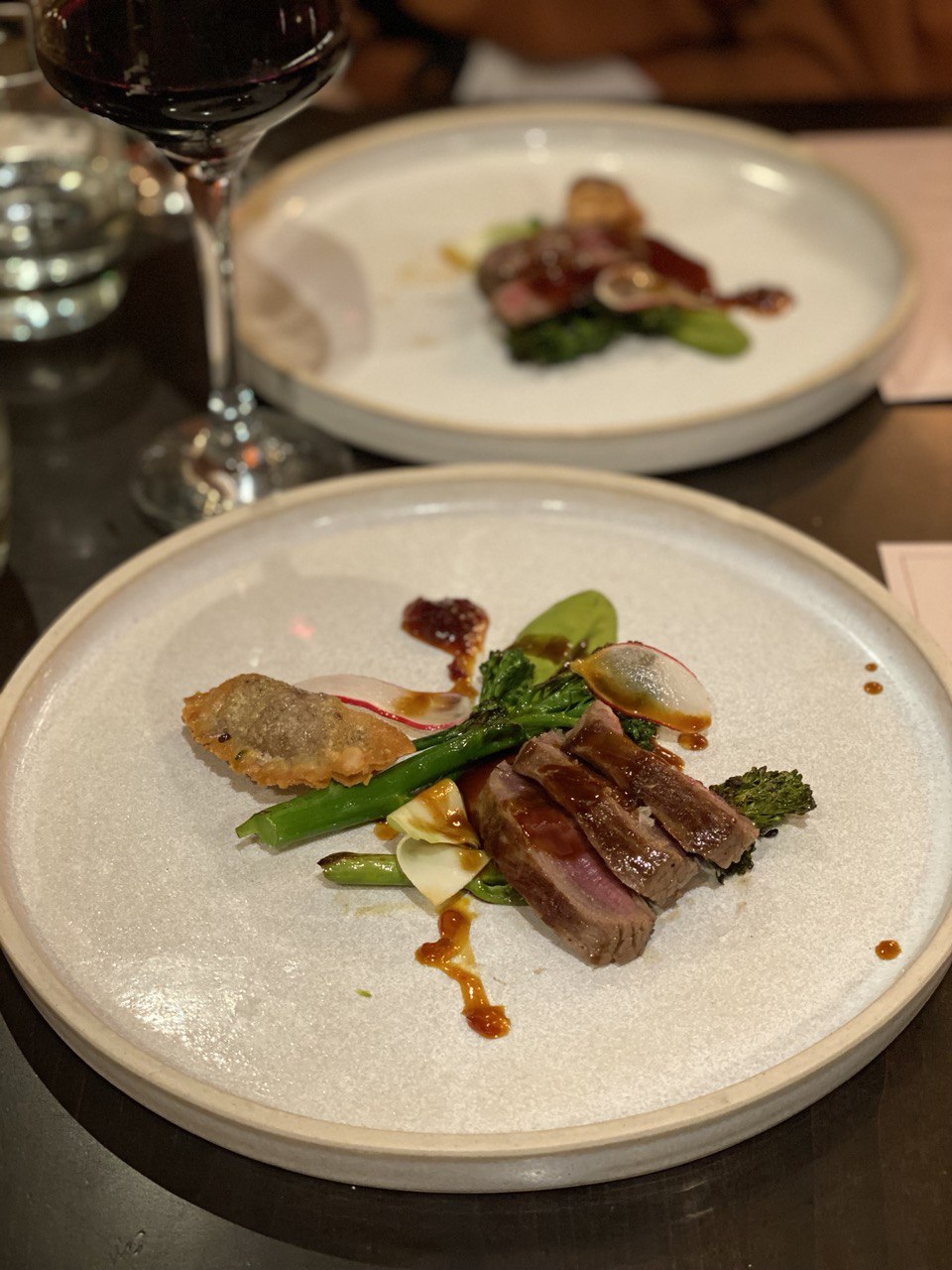
Luckily the dessert made with matcha and lychee (hence the name, a matcha made in heaven) was flawless, as well as the wine pairings throughout, so I left mostly happy.

And yet it got me thinking whether I would have a completely different experience if I had visited Shanghai prior to the dinner.
Things I enjoyed reading ¶
1. First-class flights, chauffeurs and bribery: the secret life of a private tutor by Emma Irving ¶
A hilarious story about tutors for those with lots of money (or their children). Surprisingly, the experience of tutors matters less than them being a walking example of what those parents want to achieve.
One tutor I spoke to, Frank, a graduate of Cambridge and Harvard, was ushered into a dark corner after his usual tutoring session and informed of the masterplan. The tutee’s father confided that “very good doctors” had informed him that they could inject Frank’s forehead, draw out his dna and re-inject it into his son to “make him more talented”. The father had every faith in this dubious method of transferring genetically attained talent. Alarmed, Frank pretended he was moving abroad in order to leave the family’s employ.
Given that the article mostly covers UK private schools, I wonder if any of those folks need a decent programming tutor? Asking for a friend.
2. How I accidentally took down GitHub Actions by @not_an_aardvark ¶
There are different security flaws, but my favourite ones are those that require little to none programming experience, as they mostly abuse the very fundamentals of software engineering, like this example based on hash collisions in commits:
So the good news was that I’d found a security issue which could allow any GitHub user to DoS GitHub Actions builds globally. The bad news was that I’d accidentally just DoSed a part of GitHub Actions globally.
Also comparing to many reports I've read, the responses from Github team were really fast, and sadly that doesn't happen often (although I still believe they could have offered a way more generous bounty).
3. The coupon code is a slap in the face by @mijustin ¶
The title says pretty much all. While I enjoy saving money, usually searching for a coupon doesn't really worth it. You save 5-10% or get a free delivery, but waste way more time and electricity while doing it.
You were prepared to pay the advertised price, but now you know there is a magical passcode that could get you a lower price.
You fire up Google, and search: "product name, coupon code." You get pages of results: mostly garbage, some scams, and a few legitimate coupon sites. Unfortunately, the codes listed on those sites are a year old: you missed your chance.
From the developer's perspective running promotions for everyone but briefly is way easier to build and support.
4. What happened when I stopped using Emojis by @This2ShallGrow ¶
Living without emojis shouldn't be hard, should it? 🙈🤔
Learning how they get processed by others is way harder though, hence the reason there is a dedicated committee that decides on usage for every single one of them.
They may not be language, but they still convey meaning. While burrito tinfoil and being mind-blown are pretty innocent examples, let’s look at what considerations go into trickier emojis. When designing the knot emoji, the Unicode Emoji Subcommittee wanted to make sure that when paired with a tree, it wouldn’t bring suicide or lynching connotations. Instead of their original proposal on the left, they explored different types of knots, materials, and colours, and ended up with the representation on the right.
Looking back, I think the variety of emojis I used during my very first employments was very limited (maybe to one or two, i.e smiling and sad faces), but these days, thanks to Slack's custom reactions and overall demand for being very short in communication, I feel like a lot has changed.
5. How to manually merge two Apple IDs to one by @brianstucki ¶
While the title might make it look like magic, a disclaimer is where the disclaimer is due: this is not merging but manual and careful copying of almost everything over. But still great to do one day.
Was it worth it?
Absolutely. I can’t tell you how nice it is to log in with the same email everywhere. I no longer have to remember which service is on which ID.And I totally understand why Apple doesn’t have a way to do all of this automatically. There would be so much data lost in conflicts.
As someone who moved from a country with a very limited selection of Apple services to a country where things are a tad better, I still have to constantly switch between multiple accounts (e.g Apple Music is on my older account, while most of local iOS apps are on the newer one).
Without merging them together properly, I have to do the switching dance every time I want to listen to music or get some app updated.
Family sharing helps, but not much, as these accounts belong to different regions. Hopefully, one day Apple would end up adding the automatic support for migration (and I am happy to resolve whatever conflicts they prompt manually).
6. The centuries-old sport of karate by Tony Perrottet ¶
I used to attend karate lessons in my childhood. Reading this article on its history, I start to doubt whether my childhood trainer actually learnt karate properly or just got a belt somehow and picked the discipline name randomly.
Luckily it finished after half a year, so I didn't get a chance to learn the most dangerous bits.
This hybrid martial art became known as kara-te, “Chinese hand.” There were no uniforms or colored belts, no ranking system and no standard style or curriculum. Training focused on self-discipline. Although karate could be lethal, teachers emphasized restraint and avoiding confrontation. This peaceful principle would later be codified as the dictum “no first strike."
Doesn't really explain why these days karate is one of the most competitive sports though, to the extent they finally managed to get into Olympics.
7. Building a Vision of Life Without Work by livafi ¶
This is a good essay about hobbies and overall purpose in life for those who are not sure if there is anything to do except work. The method used by the author to find out missing hobbies is worth noting too.
Nobody wants to do nothing. In fact, being placed in solitary confinement with zero stimulation is routinely used as a method of torture. It literally drives some people crazy.
People need people, and people need things to do. Much like Neo populated his Matrix, so must you populate your own domain with new stuff.
8. Dependencies by @chriseidhof ¶
Something I am very simpathetic with: avoiding dependencies as much as possible. These days my day-to-day job involves jumping between legacy and black-box third-party apps, so I hardly remember the days when I could spend a few weeks to remove a chunk of things we don't really need, but it was a jolly feeling.
It's not that I don't like third-party code. However, a lot of the projects I've worked on have been around for quite a few years — which also means keeping their dependencies up to date. Sometimes the API breaks, sometimes there are security issues, sometimes a dependency is just not maintained anymore, and very often, a dependency somehow stops working when I upgrade my machine.
I hate dealing with this.
Also maintaining or shifting to third-party solutions costs money, and comes at other expenses too.
9. London Beats New York Back to Office, by a Latte by @_jsdiamond and @tgbuckley ¶
Not a surprise, but here is an attempt to map people coming to offices and compare them to same demographics in other cities, naimely New York, just to find out that they are happy to leave houses to go to Pret but can't bother going to offices.
Pret is providing weekly data to Bloomberg about its sales across major business hubs on an exclusive basis to offer one measure of how the cities are getting back to normal. The figures give a global perspective on where there’s demand for breakfast and lunch as shoppers return to stores to splash their lockdown savings on so-called revenge spending. They also show whether employees are heeding orders from the likes of Goldman Sachs Group Inc. and Morgan Stanley to come back to the office.
Can't blame them, obviously.
10. “Cat Person” and Me by Alexis Nowicki ¶
A deep and touching story about someone who read a book that felt like something inspired by her own life. Just to realise it actually was about her own life.
When I first got off the phone with David, I felt oddly giddy. In the midst of my grief, I realized for the first time that my suspicions had been true—I could finally say for sure that “Cat Person” was about me. As the night wore on, my chest tightened. Within hours, the strange thrill I’d felt was replaced by disgust, then anger. I imagined Roupenian scrolling through my social media accounts, gathering details about me. I felt invaded.
At least it wasn't writter by Steven King.
Things I didn't know last Tuesday ¶
1. Gibraltar Airport ¶
A one more reason to go to Gibraltar: their runaway crosses a road, which should be stopped just before a plane is coming.
The lack of flat space on Gibraltar means the peninsula's only runway is bisected by its busiest road, the Winston Churchill Avenue that heads towards the land border with Spain.

And that happens at least thirty times a week!
2. Urumi ¶
A beautiful tool that looks way better than the majority of swords.
Urumi is a sword with a flexible, whip-like blade, originating in modern-day Kerala in the Indian subcontinent.

Quite surprising it was not taken into consideration by modern engineers.
3. Royal Mail rubber band ¶
Not sure if it is still a thing as I hardly seen any of them at the streets, but as a cultural phenomenon it definitely counts:
A Royal Mail rubber band is a small red elastic loop used by the postal delivery service in the United Kingdom. In the course of its work, the Royal Mail consumes nearly one billion rubber bands per year to tie together bundles of letters at sorting offices. In the 2000s, complaints about Royal Mail rubber bands littering the streets of Britain gave rise to ongoing press interest in this minor cultural phenomenon.

If you happen to know the name of the factory, check out if it trades on the stocks market. Might be worth tracking for some time closer to Christmas.
4. Vladimir Lukyanov’s Water Computer ¶
It's not like in Soviet times there was a lack of engineers, but some of them were definitely bored. How do I know? This is the only way to explain some inventions, including this one:
In 1936, a Russian engineer named Vladimir Lukyanov built such a mechanical computer that used not gears and levers but water to compute.

Jokes aside, it is quite fascinating and yet very easy to understand. It is just something not many even consider.
5. Thomas Linley the younger ¶
Apparently there was a British composer who was called "a true genius" by Mozart. The latter even said he would've been one of the greatest", but most of his compositions were lost or burnt in a fire, while Thomas drowned in a lake at age 22.
He was one of the most precocious composers and performers that have been known in England, and became known as the "English Mozart".

At least these days there are ways to make backups. Be careful in lakes anyway.
6. White Horses of Wiltshire ¶
If you sport gigantic white horses in British hills, don't freak out as this is a feature.
A contemporary engraving from around 1772 appears to show a horse facing in the opposite direction that was rather smaller than the present figure. There is, however, no documentation or other evidence for the existence of a chalk horse at Westbury before 1772.

That's actually quite a nice way to entertain hikers, quite odd no one else came up with this in other countries (at least to my knowledge).
7. Taste Garlic with your feet ¶
If you ever happen to be terribly bored, here is a fun experiment you could try:
If you stick your foot in a bag filled with garlic cloves and rub them on the bottom of your foot, you will actually be able to taste garlic! It’s not because you have secret garlic taste buds on your feet. It’s because the molecules responsible for garlic’s smell (allicin) can penetrate your skin, get into your blood and travel to your mouth and nose, where you suddenly start to sense the taste of garlic.
In the meantime I prefer to rub garlc on bread, but won't judge those who try other options.
8. Christmas controversies ¶
Among many attempts to get rid of Christmas, this one is probably one of the funniest ones as the rioters actually nearly succeed and chose to decorate doorways as a form of protest.
In 1647, the Puritan-led English Parliament banned the celebration of Christmas, replacing it with a day of fasting and considering it "a popish festival with no biblical justification", and a time of wasteful and immoral behaviour. Protests followed as pro-Christmas rioting broke out in several cities and for weeks Canterbury was controlled by the rioters, who decorated doorways with holly and shouted royalist slogans
9. Through the grapevine ¶
A beautiful way to say that comeone loves to gossip.
To hear something through the grapevine or on the grapevine is to learn about something via an informal source or hearsay, from another person; it may refer to an overheard conversation or anonymous sources of information.
The phrase might be coming from telegraps though, not grapes, as the former looks very similar to grape vines.
10. Eigengrau ¶
Another beautiful colour describing word, this time for the absence of light.
Eigengrau, also called Eigenlicht (Dutch and German for "intrinsic light"), dark light, or brain gray, is the uniform dark gray background that many people report seeing in the absence of light.
Do you think it might have an opposite one? Something for too much presence of light?
Book of the week ¶
Sometimes I think the recipes I explore already become too absurd to be worthy of time and resources, and then I come across something even more terrifying and yet very alluring. Like this idea, Matt Whiley expores in his The Modern Cocktail:
I was asked to do a pop-up bar at what was then the St John hotel (it no longer exists but it was an outpost of Fergus Henderson’s – the chef behind the amazing nose-to-tail restaurant St John) and the obvious thing to me was to try and create a cocktail using the principles of nose-to-tail eating. I wanted to make a cocktail with blood in it, so a Bloody Mary with real blood seemed like a good place to start.
The blood I use is pig’s blood. I buy it frozen in Chinatown in London but most Asian supermarkets will stock it.
I already wrote about using blood as a replacement for eggs, but here it actually affects the flavour akin black pudding, so this is definitely something new.
Also that's one of the first books where the author is stocking up on the same streets as I do (albeit half a decade earlier), so I am more optimistic about sourcing some of the ingredients.
Thank you and see you in a week! ¶
If you have any questions, or want to suggest a link for the next newsletter, please drop me a message on Twitter or reply to this email.
Cheers! 🍸